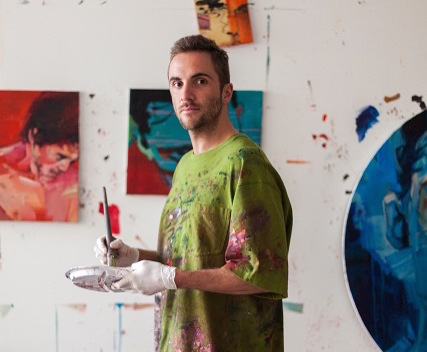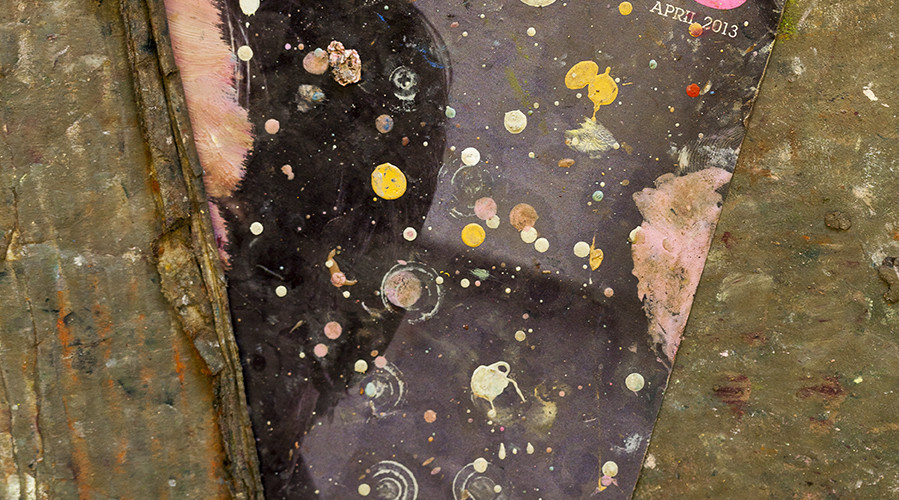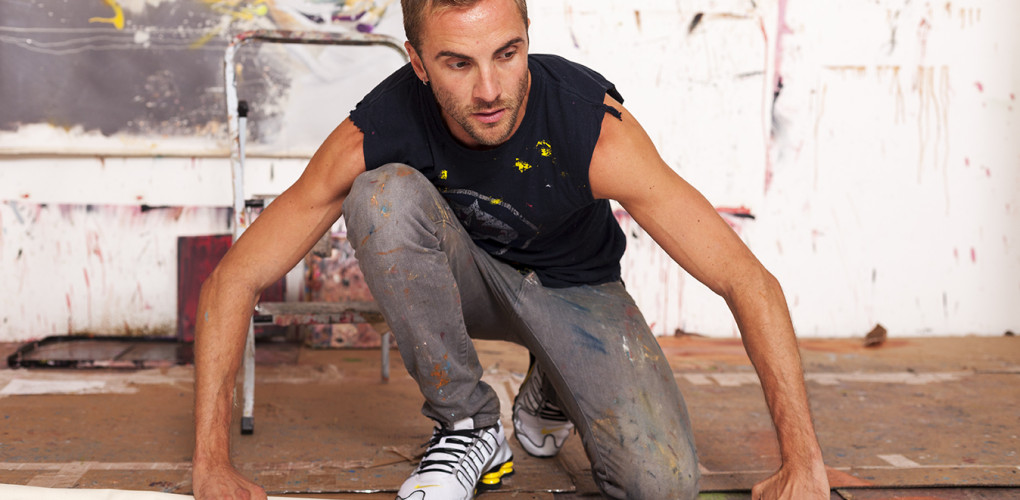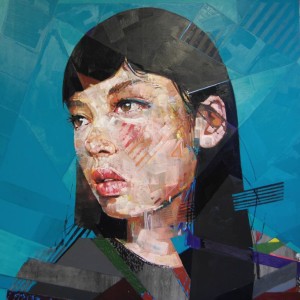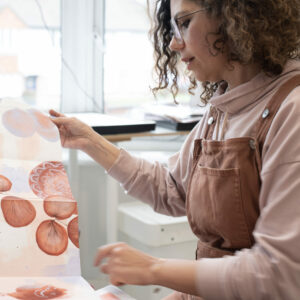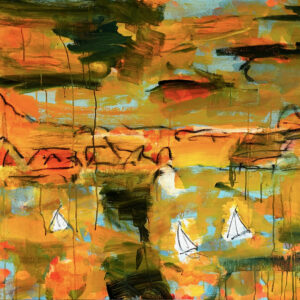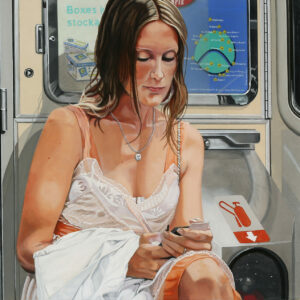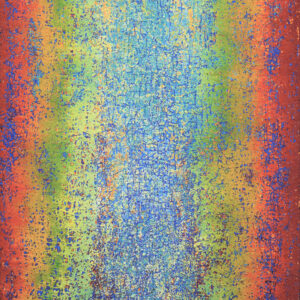One to Watch
 Andrew Salgado
Andrew Salgado
Andrew Salgado (born Canada, 1982) has an MFA (Distinction) from Chelsea College of Art, London. Since graduating in 2009 he has exhibited in the UK, Germany, Scandinavia, Australia, Venezuela, Thailand, Korea, Canada and the US, including shows with Tracey Emin and Gary Hume.
In 2011 he was part of a Channel 4 (UK) documentary What Makes a Masterpiece alongside Anish Kapoor, Howard Hodgkin and Bridget Riley. By the end of the second day of his 2012 solo show in London more than half the paintings had sold. In 2013 he will have two solo shows in Canada and one in New York. Leading critic Edward Lucie-Smith describes him as “a dazzlingly skillful advocate for the medium”. He was recently commissioned to make a series of paintings for Harvey Nichols’ windows in London’s Knightsbridge which all sold out within an hour of the preview.
How many years as an artist?
I find this a funny question because it was not as though my career was a decision I stumbled upon one day. I view art as the only aspect fundamental to who I am as a person, in the sense that, without art, I don’t think I have much of an identity. I am an artist first and foremost…that defines every other aspect of my life.
Where is your studio?
My studio is in Hoxton, in East London, actually about a two-minute walk from my flat. I’ve become so boring because my life is so focused in a relatively small area between home and work, but I love the proximity and it allows me to be fully committed to my practice. I don’t do too much except work, so I prefer to travel because it allows me to take time away from work without guilt. If I’m in London, I’m working, but it’s the only place I want to be when I’m in London.
What themes do you pursue?
I am asked this question a lot because I think my viewers want to know what propels and motivates me to work with the male figure so obsessively. Prior to 2008 I was a little less focused – certainly in terms of my subject matter and conceptual framework, I wasn’t so severe or determined – but this was a cathartic year for me both personally and professionally when my partner and I were victims of a hate-crime assault. Almost immediately, I became a political artist: I was using my art as a means to communicate what I deemed (and still deem) an important social message. In general I approach broad indefinite ideas that touch on a greater human condition, but they provide a context for me to anchor my message and explore any variety of issues that have relevance to me, and to a greater audience.
Over the course of the past few years, my work has become less evidently autobiographical, in the sense that I’m being perhaps a little more evasive about what I choose to share so readily and publicly as I mature as an artist. I’m becoming more outwardly private; while I think its okay for an artist to wear his heart on his sleeve, and is something I have done without regret, I also think that I’m not the same artist working through the same issues I was back in 2009.
So my solo exhibition last year (2012’s The Misanthrope at Beers.Lambert in London) dealt with the concept of misanthropy and whether I could look at hatred and convalescence as an external idea, using real life stories and figures from Jeffrey Dahmer to challenge myself to connect with someone I found reprehensible, to the King brothers from the United States, who murdered their father brutally after being molested by a family friend. My solo exhibition The Smallest Heart’s Desire (La Petite Mort, Ottawa, Canada, May 2013) continued this investigation, but was very aware of an idea of performance and disguise as parallels in both art and life, and moved away from real-life accounts. Certainly, who I am as a person, my own personal experiences, and my political perspective take centre-stage, even if I’m being purposefully more easive about my connection to the work.
I think it is fair to say that since 2012 I have stopped talking directly about myself and only do so now tangentially. I describe this as ripples in a pond, moving forever outward but always responsible to that initial nucleus for their existence. I love that this show is the least autobiographical but on some level its all about me, it always is about me. Its less solipsistic.
My forthcoming solo exhibition is my first museum/institution based show, and the concept has taken a backseat in favor of technique…it’s a celebration of paint. There are 8 paintings I have been working on for about 3 months. The Acquaintance runs October 9 to November 22 in my hometown at the Art Gallery of Regina).
Following this, I have solo shows in Cape Town, New York, Copenhagen, and back on ‘home turf’ in London to take me through to the fall of 2015.
What was the best advice given to you as an artist?
Without doubt the best advice I was ever given came from a gallerist friend who was helping me through one of the many ‘artist-crises’ that inevitably arise. I was creating work for a show in New York in 2011 and nothing seemed to be working, and I was immensely displeased with the results…I actually threw out about three-months worth of work, and I felt truly dislodged, as though I had fallen off track so far that I would be unable to re-situate myself again.
As an artist I think we all go through these periods where we feel as though we have inexplicably ‘lost’ our ability. It’s a foolish train of thought in retrospect, and I do think its healthy to have these periods of intense self-critique, but they can be devastating at the time. In any event, I was so distraught by all of this, and my friend just looked at me and contextualized everything; he said “you constantly expect everything that you do to work out. It’s not always going to work. Not every artist creates magic in everything he touches all the time. An author doesn’t sit down to write a book, begin at page 1 and type to page 300, send the manuscript to the editor and call it a day. No. He revises. He throws out entire chapters. He writes and rewrites whole portions of the book. It’s foolish to think that your process should be any different. All you’re doing is revising and working until you reach a successful painting. It all counts in the end.”
Since that, I’ve stopped looking at each painting as though it needs to function as an autonomous entity, and this attitude has actually allowed me to reassess my entire practice and mode of creation as a whole.
Prefer to work with music or in silence?
Music to me is crucial. Of course, we’ve all heard the belief from a particular camp that considers music to be a perversion of the artist’s true vision, as though there exists some fundamental or erroneous cause that will destroy your artistic vision if you – god forbid, listen to music while you paint – but you know, I will do whatever I need to do in studio to make myself comfortable. I don’t drink alcohol when I paint, and I know some artists that work half-drunk most days, and I don’t think them any better or worse for it. So any real practicing artist will get past these strange stigmas and work however they want, in whatever context allows them to tap into that creative source. I listen to music obsessively, and this has often greatly informed my practice. For me, there’s a brilliant marriage between the two, and to think that they are or should be mutually exclusive is foolish. The greatest brains of all time have always considered art as a whole and complex entity: think of the Italian Renaissance, these people were artists on the largest sense.
I spend the majority of my time alone, performing upon my own set of expectations, and music keeps me calm and focused. I’m very particular about what I listen to, but I think music can have beautiful effects on the brain and how that in turn affects the performance of the body, and translated thereafter to the brush upon the canvas. I tend to fixate rather obsessively on things in studio, and over the years certain albums have epitomized periods of my work. One of the first albums that struck me so profoundly while working was Kate Bush’s 2005 Aerial, which is such a complex, obsessive piece of art in and of itself that it actually changed how I worked as a painter. Antony and the Johnson’s The Crying Light was really effective, but I had to stop listening to it because it became too all-consuming, and quite sad. Some favorites since then have been Wild Beast’s Smother. St Vincent’s Actor has been played steadily for a couple of years. Wooden Arms by fellow Canadian Patrick Watson is an album of real understated brilliance. Lately I have been listening to the last Fiona Apple album, which is so raw and powerful it makes me think that’s what all art should really be like: get away the excess and find the core. James Blake is great, and lately I’ve had an album by Iamamiwhoami called Bounty on repeat that’s become my newest obsession.
What’s around the corner from your place?
My studio is just around from Pho Mile – or what I lovingly refer to as London’s Vietnamese ghetto, with such good and affordable Vietnamese. I was in Saigon last year and that just further established my fixation with Vietnamese food and culture. The new café, restaurant, and bar Beagle just opened up across the street, bringing a lot of life to the area. I’m also a big fan of Paintworks; an art store literally half a block up the road that has the best prices in London and bespoke stretcher bars at a price and quality you can’t beat.
If you couldn’t be an artist, what would you do?
I broke my arm last year and this was a pretty upsetting experience to suddenly be physically unable to paint, so I consider myself lucky every day to be able to do what I love and have people respond to it so favorably. If I was no longer able to paint, I’d probably escape to Thailand and live out my days eating curry and drinking beer.
Favorite contemporary artist?
This is a really indefinite question, and one that changes constantly and has no clear leader. I’m constantly looking at other artists – painting and otherwise – and I think this is a crucial aspect to any artistic practice. There are a lot of young, talented artists at work today in painting and otherwise, and so many are really unknown or underrated. I think its important to fuel any artistic appetite with a constant and changing array. I own a tiny Gary Hume, and I’ve always really liked his work, but I wouldn’t call him my favorite but I do respect him as a ‘thinking artist’. I also own a painting by Kim Dorland, who is quite well-known in North America but not at all well known in the UK. I’m looking to acquire a print from my friend the painter Regina Nieke, and I think Dale Adcock and Robert Fry are the best young painters working in London today.
There have been a number of painting shows to which I have had an actual physical response. This is a powerful feeling when you leave a painting show and you feel physically changed: Peter Doig, Daniel Richter, Francis Bacon, Bjarne Melgaard all had that effect on me. Shows where you leave not only reconsidering the work of that particular artist, but reconsidering the way you view art altogether. Sometimes the most brilliant feeling is when an exhibition by a younger, lesser-known artist really moves and motivates you. My gallery Beers.Lambert in London shows a lot of great painters, and often the paintings arrived rolled and because I’m local they ask me to help re-stretch them prior openings, which – if you think of it – is probably one of the most intimate ways a painter can be with another painter’s work.
If you could only have one piece of art in your life, what would it be?
Oh wow. Only one? Maybe Da Vinci’s Annunciation. Or something by Veronese… But I’ll probably have to be totally utterly predictable and clichéd and settle on something by Bacon. He’s just the best, isn’t he?
Who are your favorite writers?
Georges Batailles articulated so beautifully in prose what I was trying to get at through my painting. My favorite book is Susan Orlean’s The Orchid Thief, or Vonnegut’s Slaughterhouse V. The former being a non-fiction account of orchids that unfolds into the most sublime, romantic and ultimately tragic tale, the latter being the epitome of bittersweet historically-based science fiction…if that’s even a genre.
Is painting dead?
No. I hate this question almost as much as I hated “…yes but is it art?” while in art school. We’ve been touting the hyperbolic death of painting for nearly two-centuries. Its not going to happen, and if anything, its refreshing to see that painting is still so alive and well today and still has the power to move, shock, and surprise. Now, is photography dead? This is the question of relevance in today’s day and age. I think photographers need to be on their toes today, because anyone with a mobile device fancies themselves an amateur photographer. What is the fine-art photographer doing to set himself apart? I don’t envy my photographer peers right now because they are at a crux with the revolution of photography and its role today in art and society, and I’m eager to see how photography will evolve as a result of necessity throughout this age with such ubiquity of digital media. I seem to be the only one in the dark ages: like some sort of Luddite I have a broken DSLR on a shelf in my studio and I still don’t own a mobile, although embarrassingly I’ve been known to capture poorly framed holiday-snaps on my iPad.
Favorite brush?
DaVinci makes some short fat ones that are my crutch. I go to the art store and lust after them…they’re so expensive, and I’m so rough with brushes that they never seem to last me as long as they should, but the shorter, fatter, and wider the better. However I’ve been working with brushes with longer hairs recently and I love the subtle but marked differences its making on my work.
Monet or Manet?
I’ll have to go with Manet because of his self-awareness and sense of irony and humor. Monet is pleasant, but that’s about it, isn’t it? He’d be such a bore. If I had to choose any of the Modernists, give me Gauguin. He’s a bad-ass painter and ultimately sorely under appreciated and someone that I reckon would be a killer drinking buddy.
